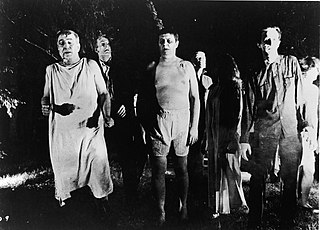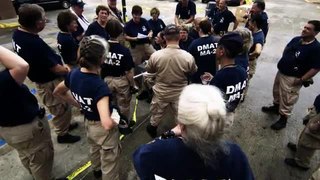
The Centers for Disease Control and Prevention (CDC) is the national public health agency of the United States. It is a United States federal agency under the Department of Health and Human Services, and is headquartered in Atlanta, Georgia.

The Federal Emergency Management Agency (FEMA) is an agency of the United States Department of Homeland Security (DHS), initially created under President Jimmy Carter by Presidential Reorganization Plan No. 3 of 1978 and implemented by two Executive Orders on April 1, 1979. The agency's primary purpose is to coordinate the response to a disaster that has occurred in the United States and that overwhelms the resources of local and state authorities. The governor of the state in which the disaster occurs must declare a state of emergency and formally request from the President that FEMA and the federal government respond to the disaster. The only exception to the state's gubernatorial declaration requirement occurs when an emergency or disaster takes place on federal property or to a federal asset—for example, the 1995 bombing of the Alfred P. Murrah Federal Building in Oklahoma City, Oklahoma, or the Space Shuttle Columbia in the 2003 return-flight disaster.
Survivalism is a social movement of individuals or groups who proactively prepare for emergencies, such as natural disasters, and other disasters causing disruption to social order caused by political or economic crises. Preparations may anticipate short-term scenarios or long-term, on scales ranging from personal adversity, to local disruption of services, to international or global catastrophe. There is no bright line dividing general emergency preparedness from prepping in the form of survivalism, but a qualitative distinction is often recognized whereby preppers/survivalists prepare especially extensively because they have higher estimations of the risk of catastrophes happening. Nonetheless, prepping can be as limited as preparing for a personal emergency, or it can be as extensive as a personal identity or collective identity with a devoted lifestyle.
Preparations for earthquakes can consist of survival measures, preparation that will improve survival in the event of an earthquake, or mitigating measures, that seek to minimise the effect of an earthquake. Common survival measures include storing food and water for an emergency, and educating individuals what to do during an earthquake. Mitigating measures can include firmly securing large items of furniture, TV and computer screens that may otherwise fall over in an earthquake. Likewise, avoiding storing items above beds or sofas reduces the chance of objects falling on individuals.

Emergency management or disaster management is a science and a system charged with creating the framework within which communities reduce vulnerability to hazards and cope with disasters. Emergency management, despite its name, does not actually focus on the management of emergencies, which can be understood as minor events with limited impacts and are managed through the day-to-day functions of a community. Instead, emergency management focuses on the management of disasters, which are events that produce more impacts than a community can handle on its own. The management of disasters tends to require some combination of activity from individuals and households, organizations, local, and/or higher levels of government. Although many different terminologies exist globally, the activities of emergency management can be generally categorized into preparedness, response, mitigation, and recovery, although other terms such as disaster risk reduction and prevention are also common. The outcome of emergency management is to prevent disasters and where this is not possible, to reduce their harmful impacts.

The National Disaster Medical System (NDMS) is a federally coordinated disaster medical system and partnership of the United States Departments of Health and Human Services (HHS), Homeland Security (DHS), Defense (DOD), and Veterans Affairs (VA). The purpose of the NDMS is to support State, local, Tribal and Territorial authorities following disasters and emergencies by supplementing health and medical systems and response capabilities. NDMS would also support the military and the Department of Veterans Affairs health care systems in caring for combat casualties, should requirements exceed their capacity. The NDMS was established in 1984.
Preparedness is a set of actions that are taken as precautionary measures in the face of potential disasters. Being prepared helps in achieving goals and in avoiding and mitigating negative outcomes.

Zombie Squad is a 501(c)(3) non-profit community service and disaster preparedness organization that uses the metaphor of a "Zombie Apocalypse" for any natural or man-made disaster. Zombie Squad was created by horror film fans who combined their shared interests of zombies and experience with disaster preparedness. It describes itself as an "elite zombie suppression task force ready to defend your neighborhood from the shambling hordes of the walking dead".

Zombie apocalypse is a subgenre of apocalyptic and post-apocalyptic fiction in which society collapses due to overwhelming swarms of zombies. Typically only a few individuals or small bands of survivors are left living. In some versions, the reason the dead rise and attack humans is unknown, in others, a parasite or infection is the cause, framing events much like a plague. Some stories have every corpse rise, regardless of the cause of death, whereas others require exposure to the infection.

The Administration for Strategic Preparedness and Response (ASPR) is an operating agency of the U.S. Public Health Service within the Department of Health and Human Services that focuses preventing, preparing for, and responding to the adverse health effects of public health emergencies and disasters. Its functions include preparedness planning and response; building federal emergency medical operational capabilities; countermeasures research, advance development, and procurement; and grants to strengthen the capabilities of hospitals and health care systems in public health emergencies and medical disasters. The office provides federal support, including medical professionals through ASPR’s National Disaster Medical System, to augment state and local capabilities during an emergency or disaster.

On December 19, 2006, the Pandemic and All-Hazards Preparedness Act (PAHPA), Public Law No. 109-417, was signed into law by President George W. Bush. First introduced in the House by Rep. Mike Rogers (R-MI) and Rep. Anna Eshoo (D-CA), PAHPA had broad implications for the United States Department of Health and Human Services's (HHS) preparedness and response activities. Among other things, the act amended the Public Health Service Act to establish within the department a new Assistant Secretary for Preparedness and Response (ASPR); provided new authorities for a number of programs, including the advanced development and acquisitions of medical countermeasures; and called for the establishment of a quadrennial National Health Security Strategy.

Ali S. Khan is an American practicing physician and former Director of the Office of Public Health Preparedness and Response (PHPR) at the Centers for Disease Control and Prevention. Since July 2014, he has served as Dean of the College of Public Health and Retired Assistant Surgeon General at the University of Nebraska Medical Center in Omaha, Nebraska.
In Emergency Management, higher learning institutions must frequently adapt broad, varied policies to deal with the unique scope of disasters that can occur in on-campus settings. Hurricanes, earthquakes, tornadoes, and wildfires are among some of the most common natural disasters that possess the capacity for large losses of life and property, with the potential to effectively destroy a university community. Man-made crises also can pose a serious threat to life and property, as was evident in the case of the 2007 Virginia Tech shooting. In order to preemptively reduce or prevent the severity of emergency situations, universities must coordinate and implement policies to effectively eliminate unnecessary risks' and decrease potential losses.
Zombie Awareness Month is a campaign to bring awareness about zombies and the possibility of a future zombie apocalypse. The campaign was introduced and is predominantly funded by The Zombie Research Society (ZRS), an organization dedicated to the historic, cultural and scientific study of the living dead that was founded in 2007. According to the ZRS, the main objective of Zombie Awareness Month is to educate people about causes, prevention and preparation for a supposed future zombie pandemic.

Emergency Responder Health Monitoring and Surveillance (ERHMS) is a health monitoring and surveillance framework developed by a consortium of federal agencies, state health departments, and volunteer responder groups designed to address existing gaps in surveillance and health monitoring of emergency responders. The framework provides recommendations, guidelines, tools, and trainings to protect emergency responders during each phase of an emergency response, including pre-deployment, deployment, and post-deployment phases. ERHMS was designed to function within the Federal Emergency Management Agency's (FEMA's) National Incident Management System (NIMS), a systematic approach to emergency management. The ERHMS trainings satisfy Public Health Emergency Preparedness capability 14, "Responder Safety and Health."

Disaster preparedness in museums, galleries, libraries, archives and private collections, involves any actions taken to plan for, prevent, respond or recover from natural disasters and other events that can cause damage or loss to cultural property. 'Disasters' in this context may include large-scale natural events such as earthquakes, flooding or bushfire, as well as human-caused events such as theft and vandalism. Increasingly, anthropogenic climate change is a factor in cultural heritage disaster planning, due to rising sea levels, changes in rainfall patterns, warming average temperatures, and more frequent extreme weather events.
Collaborating Centre for Oxford University and CUHK for Disaster and Medical Humanitarian Response was established jointly by Oxford University and The Chinese University of Hong Kong (CUHK) as a non-profit research centre to carry out research, training and community knowledge transfer in the area of disaster and medical humanitarian response in Greater China and the Asia-Pacific Region. It is housed in the CUHK Faculty of Medicine and its director is Emily Ying Yang Chan as of 2016.
ISO 22395:2018, Security and resilience -- Community resilience -- Guidelines for supporting vulnerable persons in an emergency, is an international standard developed by ISO/TC 292 Security and resilience and published by the International Organization for Standardization in October 2018. This document is a voluntary guidance standard for supporting vulnerable persons in an emergency.

Syra Madad is an American pathogen preparedness expert and infectious disease epidemiologist. Madad is the Senior Director of the System-wide Special Pathogens Program at NYC Health + Hospitals where she is part of the executive leadership team which oversees New York City's response to the Coronavirus disease 2019 pandemic in the city's 11 public hospitals. She was featured in the Netflix documentary series Pandemic: How to Prevent an Outbreak and the Discovery Channel documentary The Vaccine: Conquering COVID.
Preparedness refers to actions that are taken as precautionary measures in the face of potential disasters










